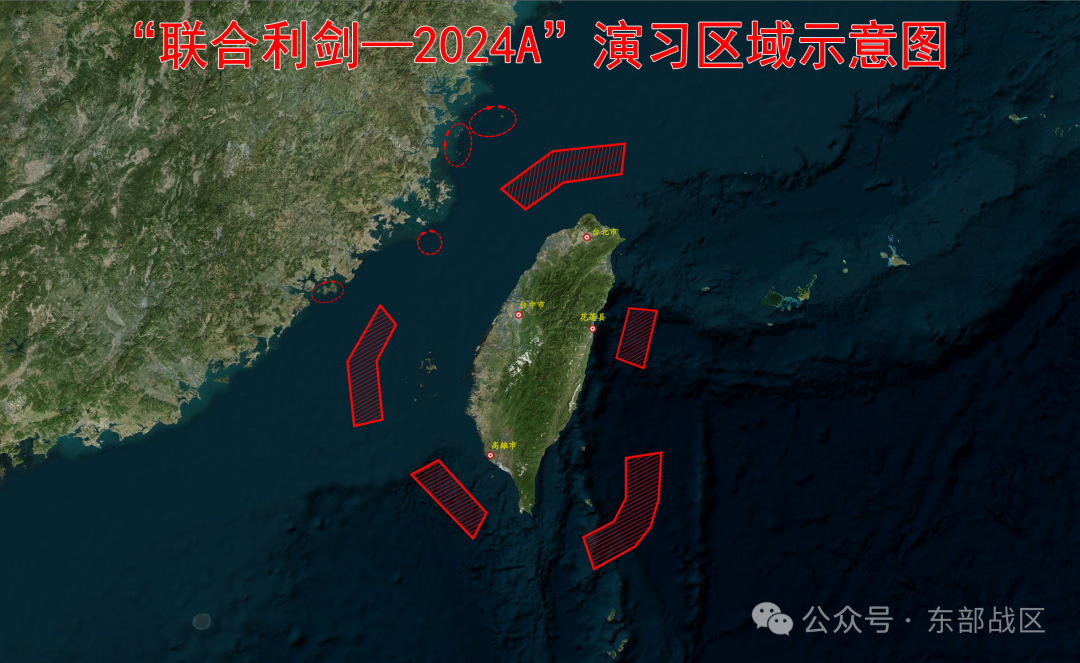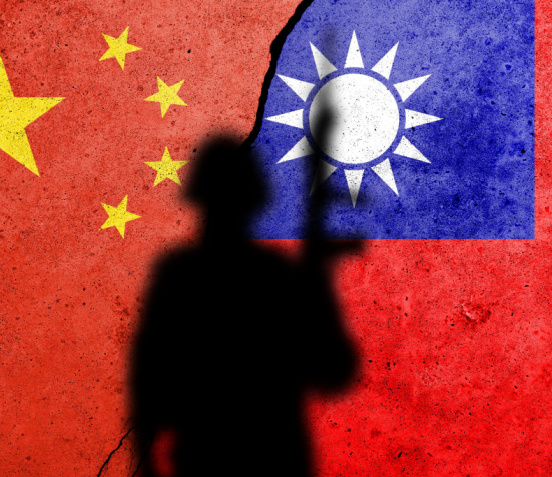On May 23, the People’s Liberation Army (PLA) launched a two-day military exercise in the wake of Republic of China (ROC) President Lai Ching-te’s (賴清德) May 20th inauguration. The exercise was the largest PLA exercise in the vicinity of Taiwan since April 2023, and had several notable features. First, while it was smaller in size and scope as compared to the 2023 exercise, it covered a larger area than 2022 and was more focused on five key areas. Second, for the first time the drill included significant coast guard activity around Taiwan’s smaller island chains. Third, the PLA named the operation Joint Sword-2024A (聯合利劍-2024A)—the same designation it gave to the 2023 operation. However, the addition of the year and letter implies that this recent exercise will be part of a future series of exercises. While these developments do not indicate an imminent invasion or other military attack, they do imply that the PLA will likely engage in further blockading drills—and that, in the future, these could expand to include Taiwan’s outlying islands.
The PLA’s Major Exercises Around Taiwan in the Past Two Years
Although the People’s Republic of China (PRC) has been steadily ratcheting up coercive military pressure on Taiwan for several years—part of a larger process of what Taiwan’s Ministry of National Defense (MND) has termed “civil attack, military intimidation” (文攻武嚇) intended to psychologically target Taiwan’s public morale [1]—the current phase of PLA political-military pressure dates to August 2022, when the PRC leadership invoked the pretext of then-US House Speaker Nancy Pelosi’s visit to Taiwan to carry out a series of large-scale military operations around the island. Those exercises represented a significant increase in more provocative actions on the part of the PRC—to include missile firings into multiple points in the sea area around Taiwan, as well as what PRC state media described as demonstrations of “sea-air joint blockade and control capability” (海空聯合封控能力). (See summary discussions of the August 2022 exercises here and here.)
The August 2022 exercises were followed by the inaugural Joint Sword (聯合利劍) exercise in April 2023, which PRC messaging linked to transit stops made in the United States by then-ROC President Tsai Ing-wen (including a meeting in California with then-US House Speaker Kevin McCarthy) while undertaking official visits to Belize and Guatemala. Highlights of that exercise included an emphasis on simulated aerial strike missions, accompanied by a high rate of sorties crossing the Taiwan Strait centerline; and as many as 80 J-15 fighter sorties from the PLA Navy aircraft carrier Shandong (山東艦), which was operating in the Philippine Sea off the southeastern coast of Taiwan. Like the August 2022 exercises, Joint Sword in spring 2023 emphasized “encirclement” operations around Taiwan—although the actual scale of operations fell fall short of the actual requirements for any effective blockade.
The Joint Sword 2024 Exercise in May 2024
After three days of relative quiet following President Lai Ching-te’s inauguration, the PLA commenced its series of military drills on the morning of May 23. The PLA Navy (PLAN), Air Force, Rocket Force, and Army were all involved, as well as the China Coast Guard. The exercise involved a total of 19 PLAN ships, 16 coast guard vessels, and 49 aircraft (35 of which flew across the Taiwan Strait median line).
The military exercise operation was divided into five main operational areas—zones in the southwest, west, north, east, and southeast. In addition to these zones, the coast guard conducted drills around Taiwan’s outlying islands. (A comparison map of the May 2024 Joint Sword exercise zones with the August 2022 exercise zones may be seen here.) While the exercise operations did not intrude into Taiwanese territorial waters (12 nautical miles from shore), the PRC’s announced exercise areas off Taiwan’s east coast (off Hualien) and to the southwest (off Kaohsiung) appeared to broach Taiwan’s contiguous zone (24 nautical miles from shore).

Image: The declared exercise activity areas for the Joint Sword-2024A exercise, involving five areas around Taiwan, and four smaller areas nearer to the PRC coast—including the Taiwan-administered islands of Kinmen and Matsu. (Image source: PRC Ministry of Defense)
Declared Exercise Areas for Joint Sword-2024A
The declared exercise areas were as follows:
- The southwest zone took place off the coast of Kaohsiung (高雄市)—Taiwan’s premier trading hub and one of the main ports for importing crude oil. The port is also home to the Zuoying naval base (海軍左營基地). This operating zone’s purpose, according to Zhang Chi (張弛) a professor at Beijing’s China National Defense University (中國人民解放軍國防大學), was to practice “strangling” foreign trade and “Taiwan’s lifeline of energy imports,” and to “block the support lines that some US allies provide to ‘Taiwan independence’ forces.”
- The western zone was an area the PLA had not featured in the 2022 and 2023 exercises. Located just west of the Penghu Islands (澎湖縣), this operating zone was meant to demonstrate the PLAN’s ability to cut off access to the Taiwan Strait. According to Taiwan’s Ministry of National Defense (MND) (中華民國國防部), three Chinese Coast Guard vessels operated south of this zone on May 23.
- The northern zone concentrated on demonstrating the PLA’s ability to position forces close to Taiwanese leadership and strike Taipei (臺北) and Taoyuan (桃園). Unlike the 2022 exercise, which had three separate zones in the area, this drill featured a single (albeit much larger) operating zone. This iteration’s operating zone was also not as close to shore as the operating zones in the 2022 exercise.
- The eastern zone near Hualien (花蓮市)—another major shipping port—focused on practicing blocking energy imports and blocking alternate escape routes for Taiwanese leadership. The PLA operated closer to the Taiwanese mainland in this zone than it did in 2022, reaching well within Taiwan’s contiguous zone.
- The southeastern zone was larger than a similar operating zone in the 2022 drill, reaching all the way to the Bashi Channel (巴士海峽) (the channel between Taiwan and the Philippines, which connects the South China Sea to the Pacific Ocean). Because of its location, the channel is not only a major economic corridor, but is strategic in military terms, serving as a regular flight path for PLA aviation assets flying to the south of Taiwan. With a US military presence in the Philippines, controlling the channel would be a necessary step to prevent foreign intervention if the PRC were to invade or blockade Taiwan.
PLA Platforms Involved in Joint Sword-2024A
The exercise featured all four combat branches of the PLA (army, navy, air force, and rocket force), and the PRC produced propaganda images of six main platforms and weapon systems that the PLA deployed for the exercise. These platforms included the J-20 stealth fighter aircraft (殲-20), the J-16 fighter (殲-16), the Type 052D destroyer Kunming (052D型驅逐艦 昆明), the Type 071 amphibious transport dock (071型登陸艦), Dong Feng (東風) series ballistic missiles, and the PHL-16 Multiple Rocket Launch System (MRLS) (砲兵火箭-16). However, while the PLA featured all these platforms in publicity materials, it does not appear that it conducted any missile live fire exercises.
It also does not appear that the PLA employed significant new platforms in this exercise, as compared to the previous two years (see comparisons here and here). The PLA deployed all the platforms it used in Joint Sword 2024A in previous exercises. In fact, in many respects this drill was more restrained than the previous two. While there were more vessels in this exercise than in previous exercises, this year’s drill was shorter and did not feature nearly as many aircraft. Likewise, fewer aircraft crossed the median line (especially as compared to April 2023). The PLA also refrained from deploying an aircraft carrier strike group as it did in 2023, and it did not declare off-limits areas for maritime traffic. Rather than testing new platforms, this drill was more focused on honing precision striking abilities and integrating the coast guard to practice “joint seizure of comprehensive battlefield control.”
The Role of the PRC Coast Guard
This was the first time that the PLA used the coast guard in a significant way in its military exercises around Taiwan. (While the 2023 Joint Sword exercise claimed to include law enforcement inspections on foreign vessels, neither the United States nor Taiwan detected such activity.) The primary focus of PRC Coast Guard activity was around Taiwan’s outlying islands of Kinmen (金門縣), Matsu (連江縣), Wuqiu (烏坵鄕), and Dongyin (東引鄉). PRC messaging described this activity as a “comprehensive law enforcement exercise… to test its joint patrol, rapid reaction and emergency response capabilities.” As part of this, the coast guard engaged in mock inspections of foreign vessels. In addition to conducting law enforcement exercises around Taiwan’s outlying islands, the PRC coast guard sent four vessels near the eastern exercise zone, and three vessels to the southern entrance of the Taiwan Strait. This suggests that the PRC was practicing using the coast guard as a supporting force for military operations around Taiwan.
PLA Political Messaging Surrounding the Exercise
On the day the drills commenced, PRC Foreign Ministry spokesperson Wang Wenbin (汪文斌) stated that “The joint drills of the PLA Eastern Theater Command are a necessary and legitimate move to safeguard national sovereignty and territorial integrity, crack down on “Taiwan independence” separatist forces and their separatist moves and send a warning to external interference and provocation.” The PRC Taiwan Affairs Office issued a statement that described the exercise as punishment for Lai’s “downright confession of Taiwan independence” in his inauguration speech.
Although the Joint Sword-2024A exercise was almost certainly planned far in advance, the PRC likely waited a few days before announcing the exercise, in order to posture it as a spontaneous response to Lai’s inauguration speech. By presenting the drills as a response to Lai’s “separatist” rhetoric, the Chinese Communist Party (CCP) leadership sought to make itself appear more measured, while painting Taiwan’s new administration as reckless and destabilizing. Shifting blame to the Taiwanese government in order to establish legal justification for military action is a typical CCP strategy, which was also seen in the previous Joint Sword exercise.
PRC propaganda materials also appeared to exaggerate live fire aspects of the exercise. For example, rather than doing live missile tests—a provocative centerpiece of the August 2022 drills—the PLA ran footage on CCTV (中國中央電視台) on May 24 of the PLA Rocket Force moving mobile artillery and missile systems into position. The reasons behind the decision to use footage instead of actual live firings is unclear, but it is possible that the CCP wanted to avoid unintended consequences like those it faced from 2022’s live fire exercises—which saw Japan deciding to develop counterstrike missile capabilities. As stated by Su Tzu-yun (蘇紫雲), the director of Taiwan’s Institute for National Defense and Security Research (國防安全研究所, INDSR), the PLA’s more restrained actions were likely “to avoid a backlash and protests from many countries.”
Conclusions
Like the previous Joint Sword drill, Joint Sword-2024A was relatively short and limited in scope. Rather than lasting for a full week like the exercise in 2022, both the 2023 and 2024 drills only lasted two to three days, and featured limited to no live fire exercises. Because Joint Sword exercises have so far been more limited, the PLA needs less time to plan them. This will allow the PRC to implement future Joint Sword operations on a shorter-notice basis, depicting them as “punishments” for ROC actions the CCP deems to be “separatist”. As further evidence of this, PRC Defense Ministry spokesman Wu Qian (吳謙) stated in reference to the recent exercise that “Every time ‘Taiwan independence’ provokes us, we will push our countermeasures one step further until the complete reunification of the motherland is achieved.”
The operation’s name of Joint Sword-2024A implies that it will be part of a series of regular drills—and that there could be a “B” planned for sometime later this year, perhaps in the autumn timeframe. While Joint Sword-2024A was not as significant as the exercises in 2022 and 2023, the implication that these exercises will become recurring events further demonstrates that the PRC is working to continue ratcheting up its coercive military pressure against Taiwan. As Deputy Commander of U.S. Indo-Pacific Command Lt. Gen. Stephen Sklenka described the matter, this most recent operation is the “normalization of abnormal actions.”
PRC messaging surrounding Joint Sword-2024A clearly indicates the preeminent role of propaganda in the operation, and of the exercise’s place in a much broader CCP campaign of psychological pressure against Taiwan and its people. However, it also demonstrates the role that such exercises play in the incremental improvement of PLA operational capabilities: as stated by analyst Eric Chan in describing the first Joint Sword of April 2023, “the scale and progression of these exercises indicate a long-term plan of action and milestones for the PLA to improve operational capability, rather than as a military demonstration alone.” Joint Sword-2024A is unlikely to be the last of its kind
The main point: The PLA conducted the exercise Joint Sword-2024A in the air and sea space around Taiwan over the course of two days on May 23-24. Although nominally undertaken as “punishment” for the “separatist” content of the inauguration speech made by Taiwan President Lai Ching-te on May 20, the exercise was almost certainly planned in advance. Although the exercise was heavy on propaganda content, such exercises also play a role in the gradual improvement of PRC military capabilities.
[1] ROC Ministry of National Defense, 2022 Chinese Communist Military Power Report [111年中共軍力報告書], September 1, 2022 (pp. 20-21).






